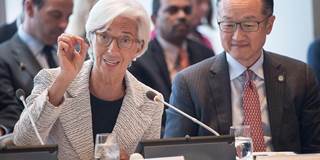The rise of anti-globalization political movements and the threat of trade protectionism have led some people to wonder whether a stronger multilateral core for the world economy would reduce the risk of damaging fragmentation. If so, enhancing the role of the IMF's incipient global currency may be the best option.
WASHINGTON, DC – The rise of anti-globalization political movements and the threat of trade protectionism have led some people to wonder whether a stronger multilateral core for the world economy would reduce the risk of damaging fragmentation. After all, lest we forget, the current arrangements – as pressured as they are – reflected our post-World War II forebears’ strong desire to minimize the risk of “beggar-thy-neighbor” national policies, which had crippled growth, prosperity, and global stability in the 1930s.
Similar considerations fueled the launch, nearly 50 years ago, of the International Monetary Fund’s Special Drawing Right as the precursor to a global currency. And with renewed interest in the stability of the international monetary system, some are asking – including within the IMF – whether revamping the SDR could be part of an effective effort to re-energize multilateralism.
The original impetus for the SDR included concerns about a national currency’s ability to reconcile the need for global liquidity provision with confidence in its role as the world’s reserve currency – what economists call the “Triffin dilemma.” By creating an international currency that would be managed by the IMF, member countries sought to underpin and enhance the international monetary system with a non-national official reserve asset.

WASHINGTON, DC – The rise of anti-globalization political movements and the threat of trade protectionism have led some people to wonder whether a stronger multilateral core for the world economy would reduce the risk of damaging fragmentation. After all, lest we forget, the current arrangements – as pressured as they are – reflected our post-World War II forebears’ strong desire to minimize the risk of “beggar-thy-neighbor” national policies, which had crippled growth, prosperity, and global stability in the 1930s.
Similar considerations fueled the launch, nearly 50 years ago, of the International Monetary Fund’s Special Drawing Right as the precursor to a global currency. And with renewed interest in the stability of the international monetary system, some are asking – including within the IMF – whether revamping the SDR could be part of an effective effort to re-energize multilateralism.
The original impetus for the SDR included concerns about a national currency’s ability to reconcile the need for global liquidity provision with confidence in its role as the world’s reserve currency – what economists call the “Triffin dilemma.” By creating an international currency that would be managed by the IMF, member countries sought to underpin and enhance the international monetary system with a non-national official reserve asset.